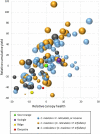SuperSour: A New Strategy for Breeding Superior Citrus Rootstocks
- PMID: 34804088
- PMCID: PMC8600239
- DOI: 10.3389/fpls.2021.741009
SuperSour: A New Strategy for Breeding Superior Citrus Rootstocks
Abstract
Citrus crops have a long history of cultivation as grafted trees on selected rootstock cultivars, but all current rootstocks have significant limitations and traditional methods of rootstock breeding take at least 2-3 decades to develop and field test new rootstocks. Citrus production in the United States, and other parts of the world, is impaired by a wide range of biotic and abiotic problems, with especially severe damage caused by the disease huanglongbing (HLB) associated with Candidatus Liberibacter asiaticus. All major commercial citrus scion cultivars are damaged by HLB, but tree tolerance is significantly improved by some rootstocks. To overcome these challenges, the USDA citrus breeding program has implemented a multi-pronged strategy for rootstock breeding that expands the diversity of germplasm utilized in rootstock breeding, significantly increases the number of new hybrids evaluated concurrently, and greatly reduces the time from cross to potential cultivar release. We describe the key components and methodologies of this new strategy, termed "SuperSour," along with reference to the historical favorite rootstock sour orange (Citrus aurantium), and previous methods employed in citrus rootstock breeding. Rootstock propagation by cuttings and tissue culture is one key to the new strategy, and by avoiding the need for nucellar seeds, eliminates the 6- to 15-year delay in testing while waiting for new hybrids to fruit. In addition, avoiding selection of parents and progeny based on nucellar polyembryony vastly expands the potential genepool for use in rootstock improvement. Fifteen new field trials with more than 350 new hybrid rootstocks have been established under the SuperSour strategy in the last 8 years. Detailed multi-year performance data from the trials will be used to identify superior rootstocks for commercial release, and to map important traits and develop molecular markers for the next generation of rootstock development. Results from two of these multi-year replicated field trials with sweet orange scion are presented to illustrate performance of 97 new hybrid rootstocks relative to four commercial rootstocks. Through the first 7 years in the field with endemic HLB, many of the new SuperSour hybrid rootstocks exhibit greatly superior fruit yield, yield efficiency, canopy health, and fruit quality, as compared with the standard rootstocks included in the trials.
Keywords: breeding strategy; citrus rootstock; fruit yield; genetic mapping; huanglongbing disease.
Copyright © 2021 Bowman, McCollum and Albrecht.
Conflict of interest statement
The authors declare that the research was conducted in the absence of any commercial or financial relationships that could be construed as a potential conflict of interest.
Figures




Similar articles
-
Genetic modulation of Valencia sweet orange field performance by 50 rootstocks under huanglongbing-endemic conditions.Front Plant Sci. 2023 Feb 8;14:1061663. doi: 10.3389/fpls.2023.1061663. eCollection 2023. Front Plant Sci. 2023. PMID: 36844073 Free PMC article.
-
Novel citrus hybrids incorporating Australian lime genetics: development of HLB-tolerant citrus rootstocks and physiological changes in 'Valencia' sweet orange scions.Front Plant Sci. 2025 Jun 13;16:1614845. doi: 10.3389/fpls.2025.1614845. eCollection 2025. Front Plant Sci. 2025. PMID: 40584869 Free PMC article.
-
Etiology of three recent diseases of citrus in São Paulo State: sudden death, variegated chlorosis and huanglongbing.IUBMB Life. 2007 Apr-May;59(4-5):346-54. doi: 10.1080/15216540701299326. IUBMB Life. 2007. PMID: 17505974 Review.
-
Incidence of 'Candidatus Liberibacter asiaticus'-Infected Plants Among Citrandarins as Rootstock and Scion Under Field Conditions.Phytopathology. 2015 Apr;105(4):518-24. doi: 10.1094/PHYTO-08-14-0211-R. Phytopathology. 2015. PMID: 25423067
-
A Mini Review of Citrus Rootstocks and Their Role in High-Density Orchards.Plants (Basel). 2022 Oct 27;11(21):2876. doi: 10.3390/plants11212876. Plants (Basel). 2022. PMID: 36365327 Free PMC article. Review.
Cited by
-
Citrus threat huanglongbing (HLB) - Could the rootstock provide the cure?Front Plant Sci. 2024 Feb 9;15:1330846. doi: 10.3389/fpls.2024.1330846. eCollection 2024. Front Plant Sci. 2024. PMID: 38405591 Free PMC article. No abstract available.
-
Genetic modulation of Valencia sweet orange field performance by 50 rootstocks under huanglongbing-endemic conditions.Front Plant Sci. 2023 Feb 8;14:1061663. doi: 10.3389/fpls.2023.1061663. eCollection 2023. Front Plant Sci. 2023. PMID: 36844073 Free PMC article.
-
Rootstock Breeding of Stone Fruits Under Modern Cultivation Regime: Current Status and Perspectives.Plants (Basel). 2025 Apr 27;14(9):1320. doi: 10.3390/plants14091320. Plants (Basel). 2025. PMID: 40364348 Free PMC article. Review.
-
Omics Profiles of Non-GM Tubers from Transgrafted Potato with a GM Scion.Food Saf (Tokyo). 2023 Feb 11;11(1):1-20. doi: 10.14252/foodsafetyfscj.D-22-00010. eCollection 2023 Mar. Food Saf (Tokyo). 2023. PMID: 36970308 Free PMC article.
-
Interactions between rootstocks and compost influence the active rhizosphere bacterial communities in citrus.Microbiome. 2023 Apr 20;11(1):79. doi: 10.1186/s40168-023-01524-y. Microbiome. 2023. PMID: 37076924 Free PMC article.
References
-
- Albrecht U., Bodaghi S., Meyering B., Bowman K. D. (2020). Influence of rootstock propagation method on traits of grafted sweet orange trees. HortScience 55 729–737. 10.21273/HORTSCI14928-20 - DOI
-
- Albrecht U., Bordas M., Lamb B., Meyering B., Bowman K. D. (2017). Influence of propagation method on root architecture and other traits of young citrus rootstock plants. HortScience 52 1569–1576. 10.21273/HORTSCI12320-17 - DOI
-
- Albrecht U., Bowman K. D. (2004). Growth comparison of citrus rootstocks after artificial infection with Phytophthora. Proc. Fla. State Hort. Soc. 117 156–160.
-
- Albrecht U., Bowman K. D. (2007). Inducible proteins in citrus rootstocks with different tolerance towards the root rot pathogen Phytophthora palmivora. J. Phytopathol. 155 606–615.
-
- Albrecht U., Bowman K. D. (2011). Tolerance of the trifoliate citrus hybrid US-897 (Citrus reticulata x Poncirus trifoliata) to huanglongbing. HortScience 46 16–22.
Publication types
LinkOut - more resources
Full Text Sources

